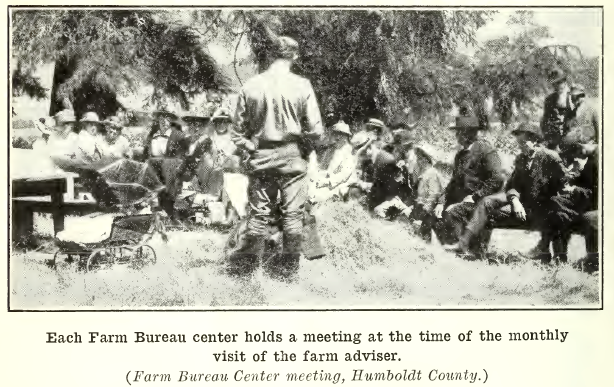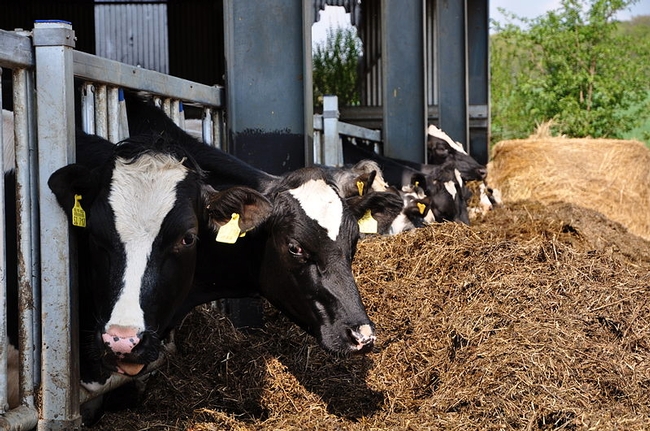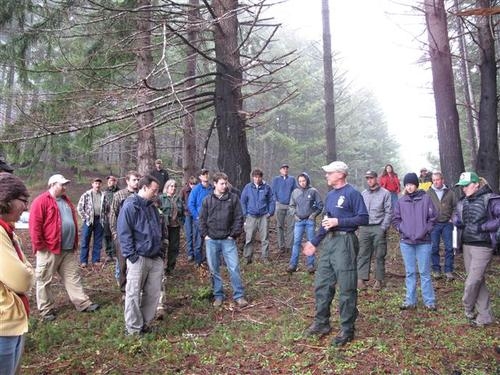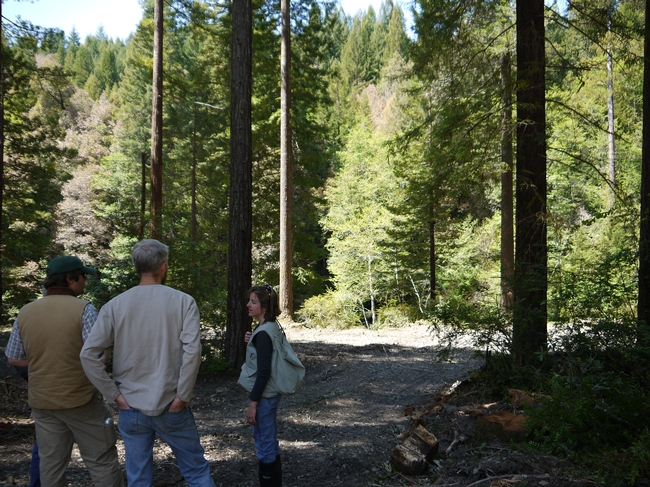Posts Tagged: Yana Valachovic
Humboldt County voters to weigh in on GMOs
Alison Van Eenennaam, UCCE specialist in the Department of Animal Science at UC Davis, said there are thousands of scientific studies that have shown that GMOs are not dangerous. Van Eenannaam herself published a review in September that examined 30 years of livestock-feeding studies that represent more than 100 billion animals. She concluded that the performance and health of food-producing animals consuming genetically engineered feed has been comparable to that of animals consuming non-GE feed.
Van Eenennaam cautioned the North Coast Journal reporter that "you can't just say 'GE is safe.'"
"That's too broad," she said. "That's like saying 'electricity is safe.' People who've been in the electric chair would disagree."
One can't say that traditional breeding is "safe," either. People have been breeding organisms to select for specific traits, and creating hybrids by crossing two species (such as a horse and donkey to get a mule) for thousands of years, the article said.
In San Luis Obispo County, where a measure banning GMOs failed in 2004, organic farmers are using buffers and communication with neighbors to allow farmers who use GMOs to coexist with non-GMO farmers.
"Coexistence is not a new idea,"said Mary Bianchi, director of SLO County UCCE. But it's been working. And, she says, nobody has pushed for a GMO-ban in San Luis Obispo County since.
The director of UC Cooperative Extension in Humboldt County, Yana Valachovic, said she and her office haven't taken a side in the debate over the Humboldt County measure.
She said she believes the issue boils down to one question: "Are we more concerned about the risks or more hopeful of the opportunities?"
UCCE leads Northern California Fire Science Consortium
Fire is the focus of increasing attention and interest in California and throughout the country. However, the interpretation and application of science remains a challenge, and fire scientists and managers often find themselves in separate spheres, with limited opportunities for shared learning and knowledge exchange.
The Joint Fire Science Program – a multi-agency program that funds wildland fire research – has recognized this issue, and fire science delivery has become one of its core objectives. Using Joint Fire Science funding, the newly formed California Fire Science Consortium (CFSC) is now a statewide educational organization with five regional teams.
UCCE staff members in Humboldt County are leading the northern California region of CFSC, along with partners from the USDA Forest Service Pacific Southwest Research Station and Humboldt State University. They have formed a multi-agency advisory committee, which includes 11 scientists and managers from different agencies and organizations in the region, to offer guidance and support for consortium activities. The Northern California team is also working closely with faculty and staff at UC Berkeley, who act as a central hub for the statewide effort.
As fire managers develop new management plans, navigate permitting and other regulatory hurdles, and attempt to adapt to changing social, political, and environmental climates, they need access to current, science-based information that is digestible and readily applicable to their unique landscapes and management challenges.
In leading the Northern California CFSC effort, UCCE has helped to harness the vast array of scientific data on fire that is applicable for the Northern California region and make it available and understandable for the non-scientific community, contributing to the integrity and efficiency of fire management, both in the region and throughout the country.
“Responses from all of our educational events suggests that we are filling a void and helping regional fire managers and landowners become aware of the latest science,” said Yana Valachovic, forest advisor and county director for UC Cooperative Extension in Humboldt and Del Norte counties.
Humboldt County led the state in establishing UC Cooperative Extension
One hundred years ago, UC Cooperative Extension was established in Humboldt County, California, a full year before the tide swept across the United States driven by the U.S. Congress Smith-Lever Act of 1914, which created such programs to serve farmers and rural families throughout the country.
The Humboldt's pioneering UCCE program was featured in a story that appeared in the Eureka Time-Standard. The rest of the UC Cooperative Extension programs will mark their 100th anniversary next year.
"We're a 100-year-old program that's been about investing in communities and people and industries,” said Yana Valachovic, UCCE country director and advisor in Humboldt County. ”It's empowerment through knowledge, empowerment through new ideas, empowerment through best practices."
In 1913, the Humboldt timber and agriculture industries were anticipating passage of the Smith-Lever Act when they organized the first farm bureau and allocated county funding to support the extension effort. That year, Humboldt County was assigned California's first farm advisor, Andy Christiansen of Ferndale.
”We really were an economic powerhouse when you think about it,” Valachovic said. “We were quite large in population, we were producing lots of goods. So it made some sense that the University of California and Humboldt County and the farmers would all come together and say, 'alright, let's figure out how to enable and put better scientific expertise within our community, so that we can work on improving our practices and improving our production and improving our overall sustainability.'”

California's first farm advisor.
Catching up on UC Cooperative Extension news over the holidays
The Redding Appeal Democrat reported in December that the ranks of U.S. farmers is dwindling. Said Sutter County almond grower Mat Conant, "Pretty soon we'll be such a small minority nobody will listen to us."
Fewer farmers means there are fewer lawmakers with first-hand knowledge of agricultural production.
"You can go to Washington, D.C., and talk about agriculture, but it doesn't have the same impact if you practically experience it," said Christopher Greer, UC Cooperative Extension director for Yuba and Sutter counties.
Lawmakers, like the people they represent, can be lulled into believing that America will always benefit from food costs significantly lower than in Europe, Greer added.
"Everyone gets a little complacent," Greer said. "We expect food to be available at a fairly reasonable price."
Historical Society presents a 'Centennial Celebration'
(Eureka and North Coast) Times-Standard
A meeting at the historical society on Jan. 5 began a year-long celebration of three Humboldt County agricultural organizations that are celebrating 100 years of service in the community: the University of California Cooperative Extension, Humboldt County 4-H Clubs and the Humboldt County Farm Bureau.
Speakers at the event, including Yana Valachovic, UCCE director in Humboldt County, were slated to highlight the roles of each of these organizations in working with youth, commodity producers and the community over the last 100 years. Many events and presentations throughout 2013 will celebrate the local agricultural community.
Far West High Cotton winner committed to finding better ways
Harry Cline, Western Farm Press
Third-generation Merced County farmer Chad Crivelli received this year's Farm Press/Cotton Foundation High Cotton Award for the Western States.
Pete Goodell, UC Cooperative Extension advisor in integrated pest management, was quoted in the Western Farm Press article announcing Crivelli's award.
"Chad meets with people during field trips to share the story about sustainable cotton," Goodell said. "He is a great spokesperson for urban folks who don’t understand what’s going on in cotton industry. He represents the cotton industry incredibly well, and the High Cotton Award is a well-deserved honor for Chad."
Crop issues test Coachella Valley vegetable producers
Cary Blake, Western Farm Press
Jose Aguiar, UC Cooperative Extension advisor in Riverside County, recounted a surprising problem with Coachella Valley peppers in 2012 at the recent Desert Crops Workshop in El Centro.
“This problem threw us for a loop,” Aguiar said. “The bell pepper had a silvering appearance on the fruit exterior. It was not found inside the fruit. It was strictly a cosmetic issue.”
Riverside County is the largest bell pepper producer in California. The Coachella Valley has about 5,000 acres of bell peppers with a farm gate value of about $90 million.
UCCE advisor Richard Smith of Monterey County has found a similar problem in red pepper fields in the Salinas Valley. After testing, Smith’s first guess is the problem could be caused by the fruit rubbing against a branch. There are no holes in the fruit which eliminates the idea of insect damage.
Victor Gibeault named 2013 USGA Green Section Award Recipient
Cybergolf
Victor Gibeault, UC Cooperative Extension specialist emeritist in the UC Riverside Department of Botany and Plant Sciences, received the 2013 USGA Green Section Award in recognition for distinguished service to golf through his work with turfgrass.
"I am both pleased and honored to have been selected to receive the USGA Green Section Award," said Dr. Gibeault. "Now retired, I have been fortunate to spend my career as a University of California Cooperative Extension specialist, and in that role, I have worked on turfgrass research issues and educational projects and programs. My activities with the golf course industry have been enjoyable, fruitful, and have given me a sense of personal accomplishment, for which I am grateful."
Gibeault holds the U.S. patents for two zoysiagrass cultivars, De Anza and Victoria, and one buffalograss cultivar, UC Verde. Additionally he co-edited the 1985 book, "Turfgrass Water Conservation."

A significant number of articles publicized UCCE activities during the winter break.
Community effort beats back sudden oak death in Humboldt County
UC, federal and state agencies and landowners in Humboldt County recently received national recognition for their collaborative efforts to halt the spread of sudden oak death. Kathleen Merrigan, U.S. Department of Agriculture deputy secretary, praised the partnership during her visit to Davis on May 16.
Yana Valachovic, UC Cooperative Extension advisor in Humboldt County, and Dave Rizzo, professor in the Department of Plant Pathology at UC Davis, were joined at the USDA offices in Davis by their partners from USDA Forest Service, CAL FIRE and the Natural Resources Conservation Service to accept the Two Chiefs’ Partnership Award. Merrigan presented the award on behalf of the “two chiefs” – the head of NRCS and the head of the Forest Service.
For me, it was a pleasure not just to see Yana’s efforts rewarded, but also to see Dave Rizzo. About a decade has passed since the days I was on the phone and email almost daily forwarding reporter requests for interviews to the UC Davis plant pathologist. Rizzo was first to identify Phytophthera ramorum as the pathogen that causes sudden oak death in 2000.
Although SOD doesn't make the news as frequently as it did in the early 2000s, it continues to spread. Garbelotto’s "SOD Blitz," his annual survey, found in 2011 that the rate of infection in trees between Napa and Carmel had grown as much as three times the rate of the previous year.
Since the disease was first reported in Marin County in 1995, it has been found in 14 coastal California counties and killed over 5 million tanoak, coast live oak, California black oak, Shreve oak and canyon live oak trees, according to the Forest Service.
UC Cooperative Extension employees were surprised in the spring of 2010 when routine monitoring near the mouth of Redwood Creek in Humboldt County detected P. ramorum in leaf samples. It meant that trees were infected somewhere in the 200,000-acre watershed – more than 50 miles from the nearest known infestation and farther north than the pathogen had ever been detected in California.
UCCE staff coordinated a swift management response, embarking on the largest SOD management project ever to occur in California. They collaborated with the Forest Service, NRCS, CAL FIRE, tribes, local timber companies and private landowners to remove infected plant material. Rizzo pitched in with diagnostics for the project and matching funds to qualify for a federal grant.
It’s still not clear how the pathogen got to Redwood Valley, said Valachovic, but it could threaten the dense tanoak forests of the surrounding area, killing trees and leaving behind dry brush, which could fuel wildfire.
Landowner support has been critical to the success of the project, according to Valachovic. More than 20 landowners in the valley have allowed monitoring and treatment activities on their properties, recognizing that their cooperation may keep the disease from spreading to other areas.
The first phase of treatment is currently wrapping up, and UCCE is beginning to monitor project efficacy and watch for spread of the pathogen beyond project boundaries. The Yurok and Hoopa tribes will be paying close attention to this effort, as they are only a ridge away from the infestation.
“Oaks are an important part of our culture and history, and we will do what we can to keep sudden oak death out of our forests,” says Ron Reed, a Yurok tribal forester.
The Redwood Valley project highlights the benefits of people working together. If you would like to report sudden oak death, you can download the OakMapper smartphone app or submit reports at the OakMapper website. The website also features a map showing suspected and confirmed cases of sudden oak death.
Scientists, managers, regulators and policymakers will gather June 19-22, 2012, to discuss the latest news about the disease at the Fifth Sudden Oak Death Science Symposium in Petaluma.
For more information about sudden oak death disease, visit the California Oak Mortality Task Force website at www.suddenoakdeath.org.







